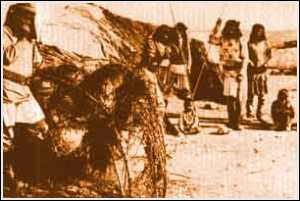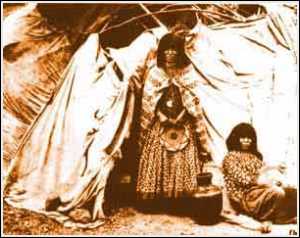 4
4
To celebrate each noted event a feast and dance would be given. Perhaps only our own people, perhaps neighboring tribes, would be invited. These festivities usually lasted for about four days. By day we feasted, by night under the direction of some chief we danced. The music for our dance was singing led by the warriors, and accompanied by beating the esadadedne (buck-skin-on-a-hoop). No words were sung--only the tones. When the feasting and dancing were over we would have horse races, foot races, wrestling, jumping, and all sorts of games (gambling).
Among these games the most noted was the tribal game of Kah (foot). It is played as follows: Four moccasins are placed about four feet apart in holes in the ground, dug in a row on one side of the camp, and on the opposite side a similar parallel row. At night a camp fire is started between these two rows of moccasins, and the players are arranged on sides, one or any number on each side. The score is kept by a bundle of sticks, from which each side takes a stick for every point won. First one side takes the bone, puts up blankets between the four moccasins and the fire so that the opposing team cannot observe their movements, and then begin to sing the legends of creation. The side having the bone represents the feathered tribe, the opposite side represents the beasts. The players representing the birds do all the singing, and while singing hide the bone in one of the moccasins, then the blankets are thrown down. They continue to sing, but as soon as the blankets are thrown down the chosen player from the opposing team, armed with a war club, comes to their side of the camp fire and with his club strikes the moccasin in which he thinks the bone is hidden. If he strikes the right moccasin, his side gets the bone, and in turn represents the birds, while the opposing team must keep quiet and guess in turn. There are only four plays; three that lose and one that wins. When all the sticks are gone from the bundle the side having the largest number of sticks is counted winner.
 This game is seldom played except as a gambling game, but for the purpose it is the most popular game known to the tribe. Usually the game lasts four or five hours. It is never played in daytime.
This game is seldom played except as a gambling game, but for the purpose it is the most popular game known to the tribe. Usually the game lasts four or five hours. It is never played in daytime.
After the games are all finished the visitors say, We are satisfied, and the camp is broken up. I was always glad when the dances and feasts were announced. So were all the other young people.
Our life also had a religious side. We had no churches, no religious organizations, no sabbath day, no holidays, and yet we worshiped. Sometimes the whole tribe would assemble to sing and pray; sometimes a smaller number, perhaps only two or three. The songs had a few words, but were not formal. The singer would occasionally put in such words as he wished instead of the usual tone sound. Sometimes we prayed in silence; sometimes each one prayed aloud; sometimes an aged person prayed for all of us. At other times one would rise and speak to us of our duties to each other and to Usen. Our services were short.
When disease or pestilence abounded we were assembled and questioned by our leaders to ascertain what evil we had done, and how Usen could be satisfied. Sometimes sacrifice was deemed necessary. Sometimes the offending one was punished.
If an Apache had allowed his aged parents to suffer for food or shelter, if he had neglected or abused the sick, if he had profaned our religion, or had been unfaithful, he might be banished from the tribe.
The Apaches had no prisons as white men have. Instead of sending their criminals into prison they sent them out of their tribe. These faithless, cruel, lazy, or cowardly members of the tribe were excluded in such a manner that they could not join any other tribe. Neither could they have any protection from our unwritten tribal laws. Frequently these outlaw Indians banded together and committed depredations which were charged against the regular tribe. However, the life of an outlaw Indian was a hard lot, and their bands never became very large; besides, these bands frequently provoked the wrath of the tribe and secured their own destruction.
When I was about eight or ten years old I began to follow the chase, and to me this was never work.
Out on the prairies, which ran up to our mountain homes, wandered herds of deer, antelope, elk, and buffalo, to be slaughtered when we needed them.
Usually we hunted buffalo on horseback, killing them with arrows and spears. Their skins were used to make tepees and bedding; their flesh, to eat.
It required more skill to hunt the deer than any other animal. We never tried to approach a deer except against the wind. Frequently we would spend hours in stealing upon grazing deer. If they were in the open we would crawl long distances on the ground, keeping a weed or brush before us, so that our approach would not be noticed. Often we could kill several out of one herd before the others would run away. Their flesh was dried and packed in vessels, and would keep in this condition for many months. The hide of the deer soaked in water and ashes and the hair removed, and then the process of tanning continued until the buckskin was soft and pliable. Perhaps no other animal was more valuable to us than the deer.
 In the forests and along the streams were many wild turkeys. These we would drive to the plains, then slowly ride up toward them until they were almost tired out. When they began to drop and hide we would ride in upon them and, by swinging from the side of our horses, catch them. If one started to fly we would ride swiftly under him and kill him with a short stick, or hunting club. In this way we could usually get as many wild turkeys as we could carry home on a horse.
In the forests and along the streams were many wild turkeys. These we would drive to the plains, then slowly ride up toward them until they were almost tired out. When they began to drop and hide we would ride in upon them and, by swinging from the side of our horses, catch them. If one started to fly we would ride swiftly under him and kill him with a short stick, or hunting club. In this way we could usually get as many wild turkeys as we could carry home on a horse.
There were many rabbits in our range, and we also hunted them on horseback. Our horses were trained to follow the rabbit at full speed, and as they approached them we would swing from one side of the horse and strike the rabbit with our hunting club. If he was too far away we would throw the stick and kill him. This was great sport when we were boys, but as warriors we seldom hunted small game.
There were many fish in the streams, but as we did not eat them, we did not try to catch or kill them. Small boys sometimes threw stones at them or shot at them for practice with their bows and arrows. Usen did not intend snakes, frogs, or fishes to be eaten. I have never eaten of them.
There were many eagles in the mountains. These we hunted for their feathers. It required great skill to steal upon an eagle, for besides having sharp eyes, he is wise and never stops at any place where he does not have a good view of the surrounding country.
I have killed many bears with a spear, but was never injured in a fight with one. I have killed several mountain lions with arrows, and one with a spear. Both bears and mountain lions are good for food and valuable for their skin. When we killed them we carried them home on our horses. We often made quivers for our arrows from the skin of the mountain lion. These were very pretty and very durable.
During my minority we had never seen a missionary or a priest. We had never seen a white man. Thus quietly lived the Be-don-ko-he Apaches.
Go to: Apache Geronimo Book Index